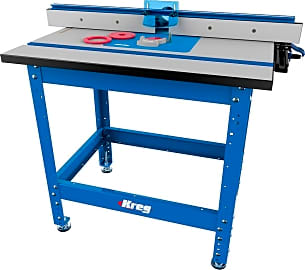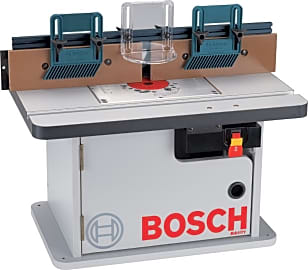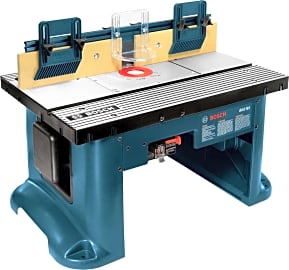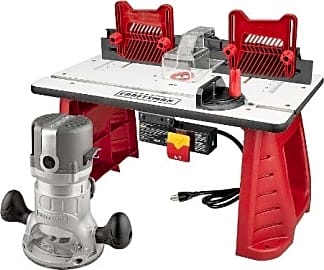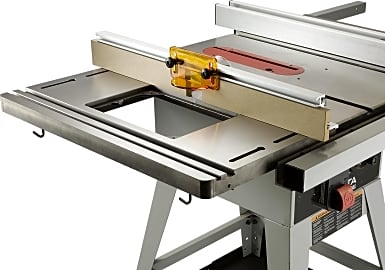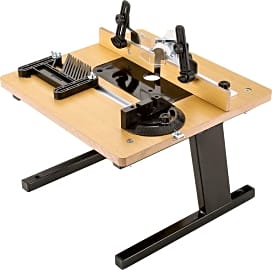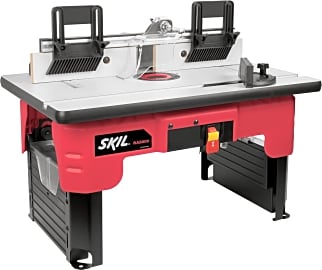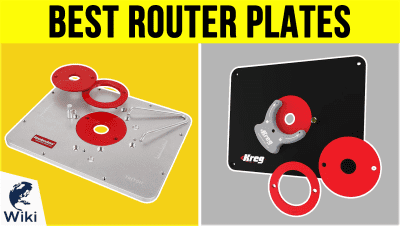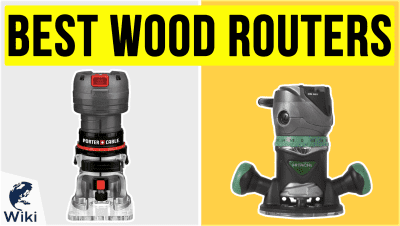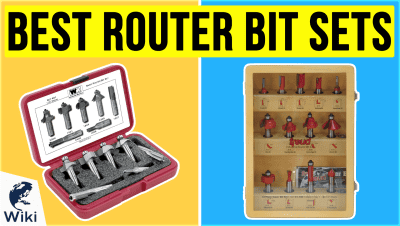The 9 Best Router Tables

This wiki has been updated 44 times since it was first published in March of 2015. Among the most versatile woodworking tools, routers can add aesthetics and structural support to many projects, and with the right table, you can create strong joinery and beautiful moldings. Because contractors and hobbyists have different needs, we've researched the top models on the market, taking into account price, durability, and efficacy, to help you determine the best one for your shop. When users buy our independently chosen editorial choices, we may earn commissions to help fund the Wiki.
Editor's Notes
November 04, 2020:
We removed the Grizzly Industrial T10432, due to numerous reported quality issues. The nature of routing requires even more precision and accuracy than most other woodworking processes, so even minor quality control issues can result in very expensive mistakes to wood pieces. Our multiple Bosch and Kreg options, like the Kreg PRS2100 and Bosch RA1171 are great examples of this type of this kind of precision craftsmanship, which is why they remain so high on our list.
We decided not to replace the rejected Grizzly model with a new entry, because after extensive research, we concluded that there were no additional options that fit our standards. We will continue to check-in and update the category regularly.
Woodworkers commonly make their own router tables according to their own preferences. If you'd prefer to save some money and customize your own table this way, consider purchasing a router plate to get you started on your project.
Regardless of which router table you choose, you'll likely need a dedicated tool to use with it. This collection of wood routers provides a nice variety of prices and styles to choose from, and these router bit sets will have you prepared to tackle any project.
If you're looking to shape or route your wood manually, these wood carving sets might give you the handcrafted look you want.
November 20, 2019:
Removed the MLCS Woodworking because of availability concerns and the Ryobi Universal because of quality concerns. Added the Grizzly Industrial T10432 and the Grizzly Industrial T1240.
Both of the Grizzly models are economical and can be used quite effectively even though both probably require some modifications. The materials used on the T10432 are not ideal but it nevertheless provides a free-standing router table for the price of a bench-mounted model. The Kreg PRS2100 takes the top stop because it is relatively affordable but made mostly out of metal parts which are less prone to warpage and damage than MDF or laminated wood.
Working with wood produces fine particles that are hazardous if inhaled for long periods of time. Always use breathing protection to avoid health complications.
All About Router Tables
This spindle protrudes up from the machine table and the workpiece gets passed along it to make cuts.
Router tables, much like handheld routers, are woodworking machines designed to rout out an area of a hard workpiece, most often plastic or wood. While handheld routers are most often used as plunging tools, table routers make use of an inverted router bit. Router tables are stationary, meaning you move your workpiece and not the tool.
Router tables are designed with a vertically oriented spindle with a cutter head attached. This spindle protrudes up from the machine table and the workpiece gets passed along it to make cuts. Typically the spindle on a router used in a router table spins somewhere between 3,000 and 24,000 RPM and can often be adjusted to match the ideal bit speed. Nearly every router table features a fence that the workpiece is slid along to control the depth of the cut.
Router tables first came about as a shop improvised tool. Some woodworkers noticed that certain pieces of stock, like those that were too small to hold steady or really long and narrow stock, were difficult to work with on a traditional handheld router. To overcome this problem, they began to mount their handheld routers in an inverted position to the underside of a table. They would then use the router's depth adjustment to extend the bit as far out from the table surface as possible.
At some point manufacturers realized that there was a need for table mounted routers and began selling accessories designed to make mounting a handheld router on a table easier, such as table inserts, specially designed table tops, hold downs, and more. Eventually this led to manufacturers selling packages which included inverted pin routers, at the commercial table router was born.
Common Uses For A Table Router
Table routers are extremely versatile workhorses that can actually take the place of a few of the other common tools found in a wood working shop. This makes it one of the most important purchases a home or professional woodworker can make when setting up a shop.
Router tables leave both hands free to hold the stock while providing support for it.
Working on overly long and narrow stock is one of the most ideal applications of a table router, especially if one uses it in conjunction with featherboards. If one has to rout hundreds of feet of molding or trim, it can be nearly impossible to produce a perfectly even cut along the whole length with a handheld router, not to mention cumbersome, time consuming, and draining on the mind and body. Long runs along narrow stock is quick and efficient with a table router.
Working on small stock is another area where using a handheld router can be difficult. They don't provide enough area to support the base of the router, so the user must concentrate on holding the router perfectly level. Adding to the problem is the difficulty of holding onto a small piece of stock because they usually cannot be clamped down in any way. Router tables leave both hands free to hold the stock while providing support for it.
Router tables are also great for edge trimming and pattern work. Since one can use two hands to hold the stock, the user can accomplish more precise work and get the job done quicker. Those who cannot afford both a jointer and a table router will be happy to learn that a table router can easily perform the tasks of a jointer. By purchasing a couple of jointing shims that fit their table routers bolt patterns, one can easily set it up for edge-jointing.
Other common uses include cutting grooves and slots, making stopped cuts, dovetails, box joints, finger joints, lock miters, and drawer locks.
The #1 Mistake People Make When Buying A Router Table
Most people buying a new tool they have never worked with before are tempted to purchase the cheapest model they can find. They do this so they can decide if they like a particular type of tool and figure out how often they will use it before making the leap into a higher priced model. While this can be a good strategy for many tools, the same cannot be said for a router table.
Not only will this making working with many pieces of stock more difficult, it will most likely unfairly dictate how useful and efficient you find a table router to be.
Except for home DIYers who rarely ever work with wood and just need to complete a single project, every single woodworker finds a router table to be an invaluable piece of their arsenal. There is a reason table routers are one of the most popular shop tools; because they are versatile, easy to work with, and extremely efficient.
Those looking to buy the most inexpensive model they can find often wind up with a router table that is too small, which severely hampers its ability. Not only will this making working with many pieces of stock more difficult, it will most likely unfairly dictate how useful and efficient you find a table router to be.
Many of the smaller tables also have parts that are not matched up to the industry standard, which means you won't be able to use many of the included accessories with other tables. Or vice versa, you won't be able to use a friend's accessories, or store bought accessories on your router table.
If you definitely have to buy an undersized router for space reasons, make sure to check that it has industry standard sizes on its accessories, especially the t-track, insert, and miter track. You'll also want to make sure you buy the right router bit for the cut you want to make.


